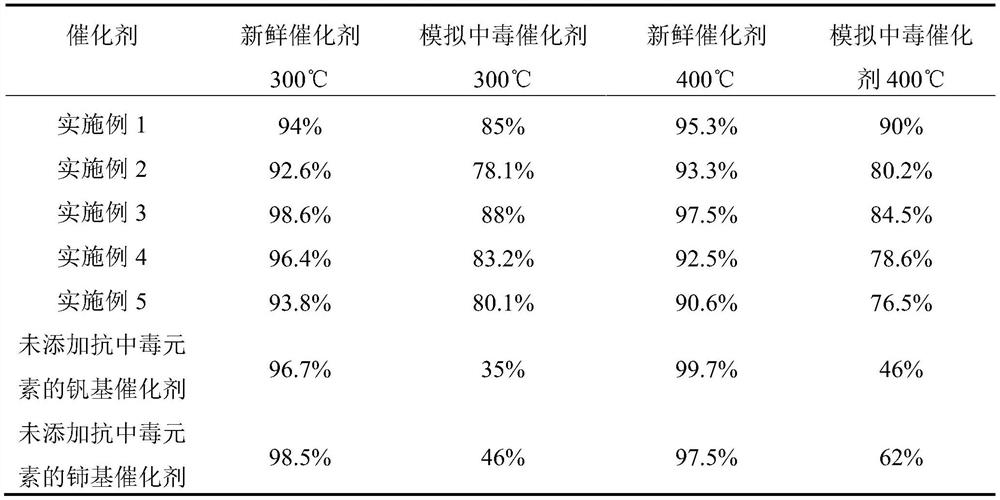A denitrification catalyst for improving anti-arsenic poisoning performance and its preparation method and application
A denitrification catalyst and arsenic poisoning technology, applied in chemical instruments and methods, physical/chemical process catalysts, metal/metal oxide/metal hydroxide catalysts, etc., can solve problems affecting catalyst activity, selectivity and temperature window , to achieve the effect of improving anti-arsenic poisoning performance, low cost, and improving anti-arsenic poisoning performance
- Summary
- Abstract
- Description
- Claims
- Application Information
AI Technical Summary
Problems solved by technology
Method used
Image
Examples
Embodiment 1
[0021] Example 1 Preparation of VWMgTi catalyst.
[0022] (1) 0.13g of ammonium metavanadate, 0.86g of ammonium metatungstate, 2g of oxalic acid and 1.1g of magnesium nitrate were dissolved in 100mL of deionized water and stirred to obtain a precursor solution;
[0023] (2) Add 9 g of titanium dioxide to the precursor solution in step (1), and stir at room temperature for 120 min to obtain a slurry;
[0024] (3) heating and stirring the slurry at 100° C., gradually evaporating the water in the slurry to obtain a solid;
[0025] (4) The solid substance obtained in step (3) is washed and filtered with deionized water several times, and then dried overnight at 110° C. to obtain a semi-finished product;
[0026] (5) Put the semi-finished product obtained in step (4) into a muffle furnace for roasting. The calcination conditions are as follows: in an air atmosphere, the temperature is raised from room temperature to 500° C. at a rate of 2° C. / min and kept for 4 hours to obtain ...
Embodiment 2
[0027] Example 2 Preparation of VWBaTi catalyst.
[0028] (1) 0.13g of ammonium metavanadate, 0.86g of ammonium metatungstate, 2g of oxalic acid and 0.34g of barium nitrate were dissolved in 100mL of deionized water and stirred to obtain a precursor solution;
[0029] (2) Add 9 g of titanium dioxide to the precursor solution in step (1), and stir at room temperature for 120 min to obtain a slurry;
[0030] (3) heating and stirring the slurry at 100° C., gradually evaporating the moisture in the slurry to obtain a solid;
[0031] (4) The solid material obtained in step (3) is washed and filtered with deionized water several times, and then dried overnight at 110° C. to obtain a semi-finished product;
[0032] (5) Putting the semi-finished product obtained in step (4) into a muffle furnace for roasting to obtain an anti-arsenic poisoning vanadium-tungsten-barium-titanium catalyst.
[0033] The firing conditions are as follows: in air atmosphere, the temperature is raised fr...
Embodiment 3
[0034] Example 3 Preparation of CeWMg catalyst.
[0035] (1) Dissolve 8.68g of cerium nitrate, 7.605g of ammonium tungstate, 2g of oxalic acid and 4.6g of magnesium nitrate in 100mL of deionized aqueous solution and stir to mix;
[0036] (2) Ammonia water with a concentration of 25 wt% was added dropwise to the solution in step (1), controlled at pH=11, and stirred at room temperature for 120 min to fully precipitate;
[0037] (3) Suction filter the precipitate obtained in step (2), and wash it with deionized water several times, and then dry it overnight at 110° C. to obtain a semi-finished product;
[0038] (4) Put the semi-finished product obtained in step (3) into a muffle furnace, and raise it from room temperature to 500°C at a rate of 2°C / min in an air atmosphere and keep it for 4h to prepare an anti-arsenic poisoning cerium-tungsten-magnesium catalyst .
PUM
 Login to View More
Login to View More Abstract
Description
Claims
Application Information
 Login to View More
Login to View More - R&D
- Intellectual Property
- Life Sciences
- Materials
- Tech Scout
- Unparalleled Data Quality
- Higher Quality Content
- 60% Fewer Hallucinations
Browse by: Latest US Patents, China's latest patents, Technical Efficacy Thesaurus, Application Domain, Technology Topic, Popular Technical Reports.
© 2025 PatSnap. All rights reserved.Legal|Privacy policy|Modern Slavery Act Transparency Statement|Sitemap|About US| Contact US: help@patsnap.com

